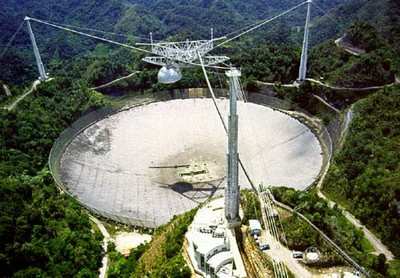Sun, Nov 22, 2020
NASA Comments on NSF’s Planned Controlled Decommissioning of Arecibo Radio Telescope
On Nov. 18, NASA was informed by the National Science Foundation (NSF) that, after careful assessment and consideration, they have decided to decommission the 305m radio telescope at the Arecibo Observatory in Puerto Rico, which recently sustained structural damage from failed cables.

The planetary radar capability at Arecibo, funded by NASA’s Near-Earth Object (NEO) Observations Program, has served as one of two major planetary radar capabilities. It has allowed NASA to fully characterize the precise orbits, sizes, and shapes of some NEOs passing within radar range after they are discovered by wide-field optical telescope survey projects.
For decades, the facility has been an important emblem of Puerto Rico’s commitment to international science research and education, and the discoveries enabled by Arecibo’s 305m radio telescope will continue to inspire the next generation of explorers. While the 305m radio telescope is being decommissioned, the Arecibo facility and its STEM education and other assets will continue.

While NASA was not directly involved in the investigation of what led to the observatory’s damage in August, the NSF communicated with stakeholders, including NASA, as their investigation proceeded. NASA respects the National Science Foundation’s decision to put the safety of those who work, visit, and study at the historic observatory above all else. NASA has facilitated some engineering assistance from NASA Centers at NSF’s request.
NASA’s Goldstone Observatory in California, another planetary radar, recently returned to full operations after successful delivery and testing of a new klystron tube for its high-power transmitter. Radars such as those at Goldstone and Arecibo are used only to characterize known NEOs, not to discover previously unknown asteroids and comets, so NASA’s NEO search efforts are not impacted by the planned decommissioning of Arecibo’s 305m radio telescope.
More News
Its Offerings Are Lighter, Cleaner, and Now Pushing Past 1,000nm on SAF Jet Fuel DeltaHawk’s diesel-powered aircraft lineup has seen incredible upgrades over the last few yea>[...]
The Airplane Experienced A Total Loss Of Engine Power On December 3, 2025, about 1600 central standard time, a Mooney Aircraft Corp. M20K, N57229, was substantially damaged when it>[...]
Make Sure You NEVER Miss A New Story From Aero-News Network Do you ever feel like you never see posts from a certain person or page on Facebook or Instagram? Here’s how you c>[...]
Aero Linx: European Society of Aerospace Medicine (ESAM) As a pan-European, independent forum, it works to promote the safety and health of all persons involved in aviation and spa>[...]
“We are excited to see Wisk achieve this milestone, and I’m so proud of the team that made it possible. The team at Wisk has built advanced technologies across flight c>[...]
 Aero-TV: DeltaHawks Diesel Power Steps Into the Spotlight
Aero-TV: DeltaHawks Diesel Power Steps Into the Spotlight NTSB Prelim: Mooney Aircraft Corp. M20K
NTSB Prelim: Mooney Aircraft Corp. M20K ANN FAQ: Turn On Post Notifications
ANN FAQ: Turn On Post Notifications ANN's Daily Aero-Linx (12.20.25)
ANN's Daily Aero-Linx (12.20.25) Aero-News: Quote of the Day (12.20.25)
Aero-News: Quote of the Day (12.20.25)




